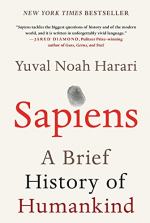
|
| Name: _________________________ | Period: ___________________ |
This test consists of 15 multiple choice questions and 5 short answer questions.
Multiple Choice Questions
1. By the first century AD, how many million foragers remained on earth?
(a) Between 6 and 8 million.
(b) Between 5 and 6 million.
(c) Between 1 and 2 million.
(d) Between 250,000 and 750,000.
2. More than what percentage of the calories that feed humanity come from plants domesticated by our ancestors between 9,500 and 3,500 BC?
(a) 75.
(b) 90.
(c) 60.
(d) 30.
3. Harari names Sapiens' first achievement after the dawn of the Cognitive Revolution as what?
(a) The colonization of Africa.
(b) The colonization of Australia 45,000 years ago.
(c) The colonization of a large number of small and isolated islands to the north of Australia.
(d) The colonization of Antarctica.
4. Before the transition to agriculture, earth was home to about how many nomadic foragers?
(a) Between 6 and 12 million.
(b) Between 9 and 10 million.
(c) Between 1 and 3 million.
(d) Between 5 and 8 million.
5. Horses had been domesticated by what year in history?
(a) 4,000 BC.
(b) 1,000 BC.
(c) 2,000 BC.
(d) 3,000 BC.
6. What dynasty united China in 221 BC?
(a) The Shang dynasty.
(b) The Sui dynasty.
(c) The Ming dynasty.
(d) The Qin dynasty.
7. Harari states that "the most unique feature of Sapiens language" (24) is that it provides its speakers with what?
(a) The ability to use voice intonation.
(b) The ability to communicate about danger.
(c) The ability to speak about fictions.
(d) The ability to solve complex problems.
8. Harari asserts that "Prior to the Cognitive Revolution, humans of all species lived exclusively" (63) where?
(a) On the landmass of the Americas.
(b) On the Austral-Asian landmass.
(c) On the Euro-Asian landmass.
(d) On the Afro-Asian landmass.
9. The mammoths of Wrangel disappeared about how long ago?
(a) 4 million years.
(b) 4,000 years.
(c) 40,000 years.
(d) 400,000 years.
10. The Cognitive Revolution occurred how long ago?
(a) Between 100,000 and 20,000 years ago.
(b) Between 70,000 and 30,000 years ago.
(c) Between 1 million and 1.5 million years ago.
(d) Between 40,000 and 10,000 years ago.
11. By what year does Harari assert that "the main wave of domestication was over" (77)?
(a) 1,000 BC.
(b) 5,000 BC.
(c) 3,500 BC.
(d) 9,000 BC.
12. Harari states that a typical forager 30,000 years ago had access to how many types of sweet foods?
(a) Two.
(b) Four.
(c) Three.
(d) One.
13. What was the largest marsupial ever to walk the earth?
(a) The saber-toothed tiger.
(b) The super kangaroo.
(c) The woolly mammoth.
(d) The diprotodon.
14. To whom does Harari allude when discussing "an objective phenomenon" (116)?
(a) Marie Curie.
(b) Louis Pasteur.
(c) Mollie Burkhart.
(d) Albert Einstein.
15. For what span of time did the "most durable human species ever" (6) survive?
(a) 50,000 years.
(b) 2 million years.
(c) 12 million years.
(d) 10 million years.
Short Answer Questions
1. The Hammurabi code divides people into two genders and three classes. What is NOT one of the three classes mentioned in the Hammurabi Code?
2. Of the 24 Australian animal species weighing 100 pounds or more, how many became extinct?
3. In a band of 50 individuals, Harari states that there are how many one-on-one relationships?
4. The last Ice Age that happened on Earth occurred during what span of time?
5. Around what year did global warming melt the glaciers blocking the way from Alaska to the rest of America?
|
This section contains 473 words (approx. 2 pages at 300 words per page) |

|




